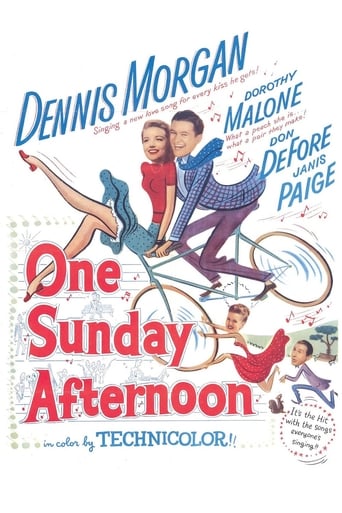Roy Hart
If you're interested in the topic at hand, you should just watch it and judge yourself because the reviews have gone very biased by people that didn't even watch it and just hate (or love) the creator. I liked it, it was well written, narrated, and directed and it was about a topic that interests me.
tles7
At times the dialog is the same as The Strawberry Blonde. and of course Blonde is a better film. But, this is a fun musical and it has the wonderful Janis Paige who was a fine stage performer and was the lead in the original Bway production of The Pajama Game. What you rarely see in musicals of that era is live singing (never at MGM). However, in this movie several of the musical numbers are sung live and it make a huge difference. It's truly where you see how real the talent is of the performers. Speaking of talent, those viewers that have seen the Cagney version will marvel at how much better the dramatic scenes between Cagney and DeHavalind are than the those with Paige and Morgan....which are basically word for word the same. It's a tribute to Cagney's talent and charisma. The movie that made Rita Hayworth a star.
Tom Hodgins
Raoul Walsh returned to the same source material that he had explored seven years before when he directed Warner Brothers' One Sunday Afternoon in 1948.Previously titled The Strawberry Blonde, starring James Cagney at the peak of his career as Biff Grimes, a pugnacious dentist in turn-of-the-century New York City who fantasizes about the title character, it, in turn, had been a remake of a 1933 Paramount production with the same title as the '48 version. That version had featured a young somewhat gawky Gary Cooper playing Grimes.The '48 version, with Dennis Morgan now playing the dentist, was updated in two respects. It was turned into a partial musical to take advantage of its star's musical talents, and was filmed, impressively, in Technicolour. No matter whatever flaws this third version had, it was a handsome looking production.The musical numbers are pleasant but bland and, quite frankly, could have used the memorable song "The Band Played On," as heard repeatedly in the Cagney version.The cast of the '48 version (which includes Dorothy Malone in the role of Amy Lind, previously played by Olivia De Havilland in the '41 version, along with Janis Paige replacing Rita Hayworth as the title character, and Don DeFore in the Jack Carson role as chief protagonist) strives for adequacy but truly pales next to the memorable performances of the first Walsh version. Completely jettisoned from this version is the role of the dentist's rogue father, previously cheerfully played by Alan Hale. Almost for old time's sake, however, Hale's son, Alan Jr., has a small supporting role.Looking ill at ease in this version's earlier scenes is star Dennis Morgan. Morgan had a natural cheerful, laid back charm and watching him play a character who is impulsive and pugnacious (a natural piece of casting for Cagney) is painful, to say the least. Morgan is more comfortable when he has the opportunity to sing, which he does with his usual charm.Janis Paige makes little impression as "the strawberry blonde," the object of all men's desires, is this film, certainly nothing to compare to Hayworth seven years before. Don DeFore, while no Jack Carson, is not bad in the role of conniving Hugo Barnstead, while Dorothy Malone, as patient, loving Amy, the girl who is the real gem in the film, is reasonably touching in her role. She doesn't bring the same depth and warmth that De Havilland had but it's still a commendable performance.In retrospect, director Walsh perhaps returned once to the well once too often with this production. Aside from the '41 version of Strawberry Blonde, Walsh, who had been raised as a boy during the Gay '90s, had a special affinity for creating nostalgic films of that era. The '41 Blonde is a minor under appreciated masterpiece but Walsh had made a few other memorable excursions into that era, as well, with 1933's The Bowery, 1936's Klondike Annie, with Mae West, and, best of all, 1942's Gentleman Jim, a rollicking affair, and another minor masterpiece, marking Errol Flynn in one of the most charismatic performances of his career.This '48 version of One Sunday Afternoon can best be described as a rather bland time waster, hardly representative of Walsh at his best. Then, again, there's only so much the director can do when he has a willing but lesser league cast of players. There is no Cagney anywhere in sight of this production, and he is a talent that is sorely missed.

